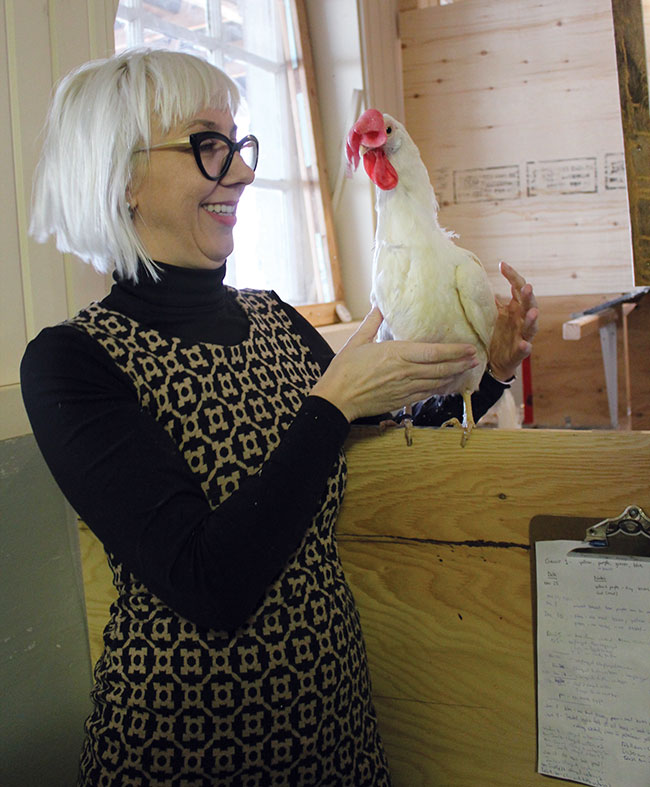
The keel bone connection
By Lisa McLean
Features HousingFor laying hen health in complex housing systems, think like a ground bird.
 Dr. Alexandra Harlander is an animal biology researcher at the University of Guelph.
PHOTO CREDIT: Dr. Alexandra Harlander
Dr. Alexandra Harlander is an animal biology researcher at the University of Guelph.
PHOTO CREDIT: Dr. Alexandra Harlander Keel bone fractures and feather loss are common challenges affecting laying hen health. Keel bone fractures are reported in up to 98 per cent of chickens and feather loss can occur in up to 95 per cent of birds. Now, thanks to new work, researchers have a better understanding of how the injuries are connected and how they might be prevented.
Dr. Alexandra Harlander, animal biology researcher at the University of Guelph, says recent work that looks at chicken locomotion capabilities provides important insight into multiple factors that impair a chicken’s flight abilities. With new understanding of how feather cover, flapping flight mechanics, navigation skills and adaptability play a role, she says farmers can find creative solutions for hen health.
The work is part of a larger study led by Dr. Tina Widowski, with partners across Canada and the U.S., that aims to understand a laying hen’s bone health and behavioural adaptations to complex housing systems, leading to healthier hens until end-of-lay.
Crashes happen
In aviaries, hens have space to roam and fly – and must also navigate around structures to access food and water or to respond to threats. Birds in these systems are also more prone to crashes that may lead to keel bone fractures. Harlander says that’s half the story.
“Keel bone fractures and feather cover go hand in hand and it was a unique approach to combine the two,” she says. “If a bird doesn’t have proper feather cover, they have trouble getting up and down and they may have trouble navigating – but the problem is actually much more complex.”
Laying hens commonly experience feather loss due to normal wear-and-tear, disease and bird-to-bird pecking. To test how poor feather cover would impact flight skills, Harlander’s research team worked with Dr. Bret Tobalske from the University of Montana to analyze flapping flight performance due to wing condition.
“Chickens are ground-dwelling birds and are not good flyers,” she says. “They perform flight mainly to escape predators and to roost. If they are outside and they see a tree, they navigate their way up and down on low branches and fly directly down.”
Harlander’s team analyzed the flapping flight of chickens with various wing clipping treatments. They found that even birds with a fully intact feather cover could only support 80 per cent of their body weight. Birds with half-clipped feathers supported less than half their body weight in flight, while navigating down from a height of 1.5 metres. In large aviaries, chickens often navigate spaces that are several metres high.
“This study proved the flight capacity for layers is already poor. In commercial conditions, there are thousands of birds in the landing area and crashes occur if a bird is already having challenges navigating.”
Use it or lose it
Egg-laying hens are heavy birds with strong leg muscles for walking, running, jumping and scratching. Flight muscles are large and place significant force onto the keel bone. In another part of this study, Harlander’s team assessed the impact of feather loss and accompanying muscle weakness on keel bone fracture.
The researchers clipped primary and secondary flight feathers in white-and brown-feathered birds and used ultrasound to measure changes in pectoral (breast) muscle thickness. They also used X-rays to assess the prevalence of keel bone fracture.
“If birds adapt to a more sedentary lifestyle as they lose feathers, they may be more likely to become weaker,” Harlander says. “We wanted to understand if a weaker keel bone is subject to fracture during bouts of vigorous wing flapping, which is a common occurrence during fear/panic responses or slips.”
Previous research has measured the weight of the pectoral muscle. Harlander’s work using a portable ultrasound machine is unique because it provided a way to measure the muscle’s thickness on live birds.
Her team found evidence that feather damage alters a chicken’s morphology – particularly among white-feathered laying hens, through a significant decrease to bodyweight and pectoral muscle thickness. However, feather damage and subsequent muscle thickness were not associated with keel bone fracture.
What it means for farmers
“Our results suggest that other untested factors likely function in the development of keel bone fractures, and we need further investigation because of the implications for animal welfare and rearing economics,” Harlander concludes.
This research is funded by the Canadian Poultry Research Council as part of the Poultry Science Cluster which is supported by Agriculture and Agri-Food Canada as part of the Canadian Agricultural Partnership.
Print this page